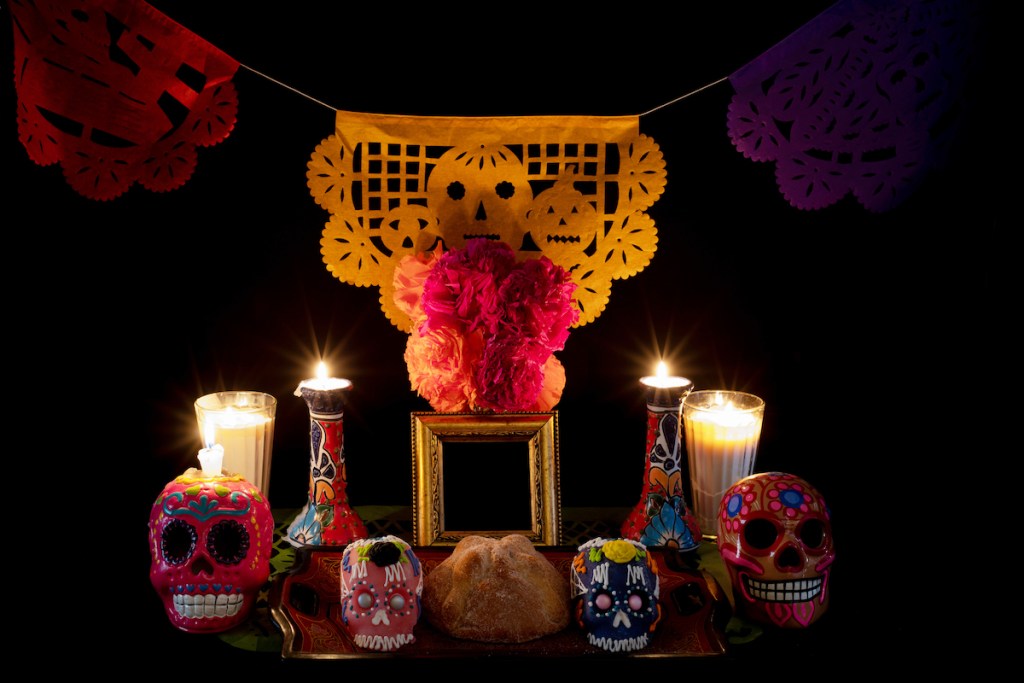The roots of Día de los Muertos ― also called Día de Muertos ― date back thousands of years, when early Indigenous groups in present-day central Mexico honored their dead and provided them with food and tools to aid them in el más allá ― the afterlife.
This tradition has miraculously persisted in various forms since then, inspiring celebrations on November 1-2 throughout Latin America and Latino communities in the U.S. and beyond.
Today ― amid colonization, the melding of cultures and religions, and Disney and Pixar’s Coco ― what does celebrating Día de los Muertos look like?
In Santa Barbara, Maria Caudillo sets candles and fragrant cempazúchitl (marigolds) on the Día de los Muertos altar in her home. The cempazúchitl scent is said to help guide the dead to the altars, where they’ll also find their favorite food and drink, and photos and personal items placed there by their living family members.
The altars, or ofrendas, act as portals for deceased loved ones to cross through, in order to celebrate and spend time with the living. “My mom used to say you should always put water [on the altars], too,” Caudillo said, “because [the dead] are coming back from a very long trip, and they might be thirsty.”
Like Christmas or birthdays, Día de los Muertos has long been a regular ― and essential ― holiday for Caudillo and her family. Originally from Romita, Guanajuato, in central Mexico, she has observed it since she was a child, helping her family visit and clean their loved ones’ graves, and adorn them with candles, flowers, and bites to eat for the occasion: tamales, atole, and pan de muerto.
Caudillo and her family moved to Santa Barbara when she was 8. For a long time, they couldn’t visit the cementerio in Guanajuato, so they’d build a home altar and pray and tell stories about their relatives on the other side.
Sign up for Indy Today to receive fresh news from Independent.com, in your inbox, every morning.
Today, the molcajete (mortar and pestle) that belonged to Caudillo’s Tía Faustina is a regular item on her Día de Muertos ofrenda. “[My Tía Faustina] was basically our grandma, and she was such a loving and beautiful person,” Caudillo said. “[For Día de los Muertos], we’d tell stories of her, about how she’d give us hot tortillas fresh off the comal … you just always felt the love from her.”
Gloria Sanchez-Arreola recalls observing Día de los Muertos at church, as it coincides with the Catholic celebration of All Souls Day. The daughter of Mexican immigrants who grew up in Los Angeles, Sanchez-Arreola eventually learned the Indigenous history of Día de los Muertos as a UCSB college student, about 20 years ago.
The holiday centers around the belief that humans exist in a cyclical world. Death is simply part of that cycle, and it doesn’t necessarily signify darkness or loss. Rather, it’s a passing on to the next phase of existence from which spirits can return.
As the holiday occurs around the time of the fall cosecha, or harvest, we are reminded that nature is cyclical, too. In fact, ofrendas are often created with natural elements in mind, since incorporating wind, fire, earth, and water are ways to pay homage to the land and to life itself.
These discoveries inspired Sanchez-Arreola to be proud of her cultural roots and traditions, and to organize spaces for others to foster that same connection to their heritage. “I just never grew up with a practice where I gave my ancestors an offering, and I have some grief about that,” she said. “So, through my grief, I’ve sought out community to co-create this practice for the next generation.”
Caudillo will combine Día de Muertos festivities with Halloween, and celebrate with her extended family. For her, this “profound and ancient” tradition is simply about “creating sacred space.”
“It doesn’t matter how humble your altar is or how extravagant it is, as long as you’re creating a sacred space to be able to remember your loved ones and use it as storytelling,” she said, “and passing that on to the next generation.”
Public events are also part of citywide Día de los Muertos celebrations, and several are happening the following weekend. Check the Independent’s calendar section for the full listings.
Support the Santa Barbara Independent through a long-term or a single contribution.

